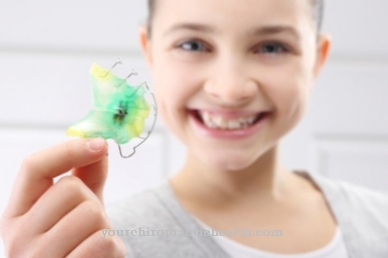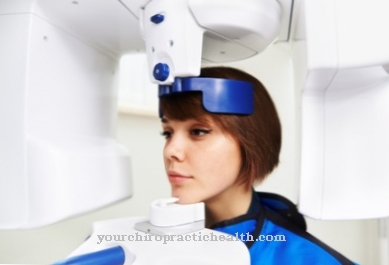Hydrogen peroxide-Solution is available in pharmacies in various concentrations. The user can purchase the over-the-counter product for bleaching his teeth (bleaching) and for various medical applications. For safety reasons, higher concentrated, non-stabilized hydrogen peroxide is not handed over without a certificate of use.
What is hydrogen peroxide?

Hydrogen peroxide, chemical H2O2, will also be Perhydrol and Hydrogen peroxide called. It is a light blue liquid that, when diluted, is colorless. The weak acid is a highly effective bleaching and disinfecting agent. It was first produced synthetically in 1818.
Solutions with a maximum of 12 percent hydrogen peroxide are freely available in stores. Solutions with a content of more than 5% are specially marked. Hydrogen peroxide can be used in many ways. In the food industry, it is used as a disinfectant when cleaning PET bottles and other outer packaging. In other industries it is used to bleach paper, pulp and textiles. In natural medicine it is used for various diseases. In small quantities, it is even produced by the human body itself.
Function, effect & areas of application
H2O2 works in all available concentrations. 3 percent hydrogen peroxide solutions are used in households for cleaning. Because of their intense oxidative effect, hairdressers use them in low concentrations as hair bleaching agents and for setting permanent waves.
In medicine and dentistry it is used as a disinfectant against fungi, bacteria and viruses. The solution is used to clean surfaces, instruments (plasma process), mucous membranes and hands (to prevent infectious diseases). As part of dental treatments, it is used to sterilize teeth and gums, mouth and throat. In addition, hydrogen peroxide solution has a preventive effect against gingivitis and bacterial plaque.
During dental operations, it stops bleeding. As a means of whitening teeth, it is used in the dental practice and at the user's home. The user applies the agent as a gel or sticks a bleaching strip on the front of his teeth. Tooth splints individually manufactured by the dentist ensure that the whitening agent does not fall apart so quickly. Depending on the desired level of brightness, a more or less high-dose H2O2 solution is used. H2O2 is found in contact lens cleaning agents and - also in low concentrations - in mouthwashes and toothpaste.
Hydrogen peroxide is a colorless, non-toxic, non-flammable and almost odorless solution that can be diluted with water. It has a higher density and viscosity than water. With pure H2O2 the melting point is -0.43 ° C. The boiling point of pure hydrogen peroxide is 150.2 ° C. Highly concentrated and in the presence of metals, hydrogen peroxide breaks down immediately into water and oxygen. Therefore, the H2O2 sold in stores usually contains stabilizers.
Since 30% solutions decompose quickly, the user should always prepare them fresh. They are a powerful oxidizing agent that is formed in the body in many biochemical processes such as the conversion of sugar.So that it is not toxic to the organism, it is broken down by catalases and peroxidases (enzymes) into oxygen and water.
In alternative medicine, the solution is used in different concentrations, depending on which diseases are to be treated with it. The external application with hydrogen peroxide enables skin tumors (basaliomas) to reduce the radiation dose by about half. The cancer cells are destroyed by the supply of oxygen. As carbamide peroxide (contains urea) or as a 35 percent solution, it heals psoriasis, acne, skin allergies and other itchy skin diseases. For skin problems, a bath with 500 ml of 30 percent H2O2 solution is also recommended, which is mixed with 110 liters of water. Applied as a gel in ten percent concentration, it helps with athlete's foot and chickenpox.
Three percent hydrogen peroxide solution can be used against an infection with wart viruses. In the case of insect bites, it relieves itching and reduces swelling. Used internally in very low concentrations, it stimulates the immune system and prevents infections. In the uterus and breast cancer, it prevents odor-causing bacteria. To do this, it is simply applied to a cotton wool pad and applied externally. In a 10 percent ointment that is applied every two days, it helps against circulatory disorders in the legs. Foot baths with a 3% hydrogen peroxide solution have the same effect. A small amount of the diluted solution helps against gastritis, typhoid, cholera and as a preventative against the yellow fever virus.
Risks, side effects & dangers
If the user inhales a highly concentrated hydrogen peroxide solution, it causes burns of the airways, inflammation of the mucous membranes and pulmonary edema. Even diluted H2O2 will bleach the skin if the user does not immediately rinse it off thoroughly with water.
If the solution gets into the blood through the skin or stomach, it can lead to dizziness, headaches, diarrhea, vomiting, cramps, circulatory problems and even death from suffocation: The foam formation in the stomach can cause breathing to stop. If unstabilized solutions with a concentration of more than 12 percent are heated or if they come into contact with heavy metals, spontaneous explosions can occur. Even 6 percent solutions are no longer considered safe if the user wants to use them as a bleaching agent.
For users who whiten their teeth with hydrogen peroxide solutions, it sometimes attacks plastic and amalgam fillings. This can also damage the dentures. Since small amounts of the substance get into the pulp during bleaching, they can cause inflammation there, at least in sensitive users. In addition, the teeth may become more sensitive to temperature and the oral cavity may be irritated, but these usually subside after a few days.



























